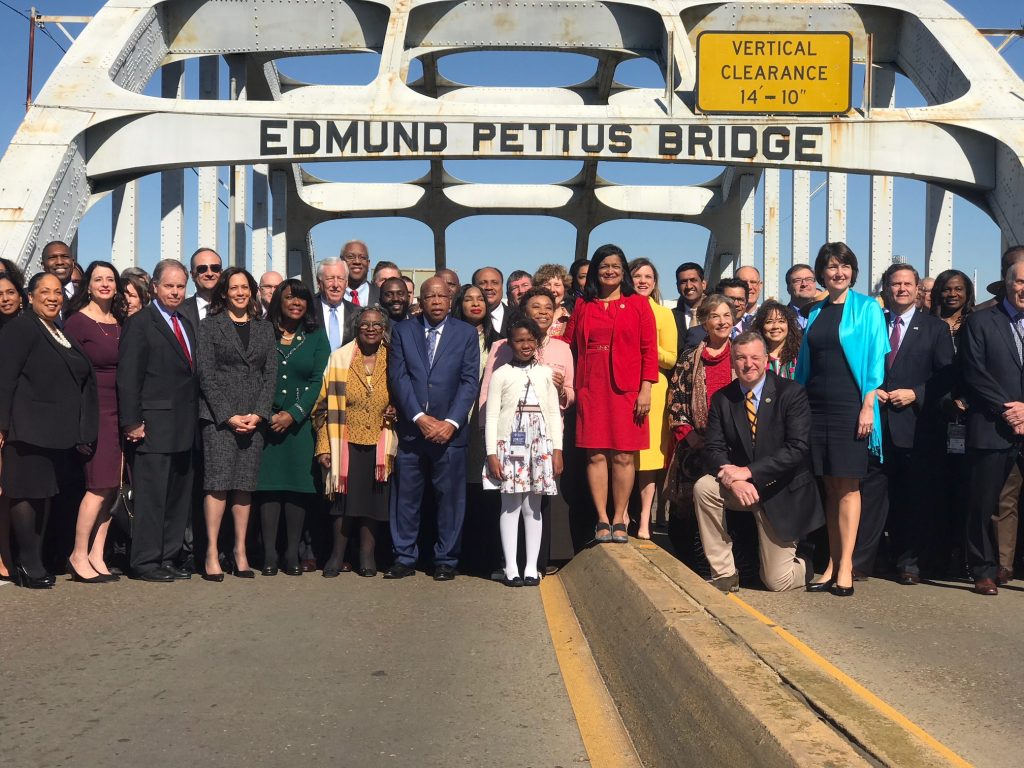
U.S. Senator Doug Jones is seen here with Georgia Congressman John Lewis on what should soon be the John Lewis Memorial Bridge. Notice too that House Majority Leader Steny Hoyer was there that day too: Facebook
By Glynn Wilson –
In discussing death, people often talk about someone’s “untimely death” when a person dies relatively young and suddenly. Civil Rights hero and Atlanta Congressman John Lewis was not young and his death was not sudden. He was 80 when he died on Friday from pancreatic cancer, which he had announced to the world back in December.
Considering the outpouring of emotion from the world in reaction to his death, and considering everything else that is going wrong in the world, his timing seems almost immaculate, as it was back in 1965 when he challenged Martin Luther King, Jr. and others in the movement to take on George Wallace and the Alabama State Troopers head on by leading a march across the Edmund Pettus Bridge in Selma on March 7, 1965. Remember, Dr. King was not there that day.
Without John Lewis, and his study of Mahatma Ghandi’s tactic of non-violent confrontation, there may never have been a successful Selma-to-Montgomery march led by Dr. King or a Voting Rights Act of 1965.
It was his Student Nonviolent Coordinating Committee that led the march on the day that came to be known as Bloody Sunday. So as a movement goes forward to rename the bridge, it is the name of John Lewis that should appear on it, and there should be no debate about that.
“Generations from now, when parents teach their children what is meant by courage, the story of John Lewis will come to mind — an American who knew that change could not wait for some other person or some other time; whose life is a lesson in the fierce urgency of now,” former President Barack Obama said of Lewis upon reacting to his death.
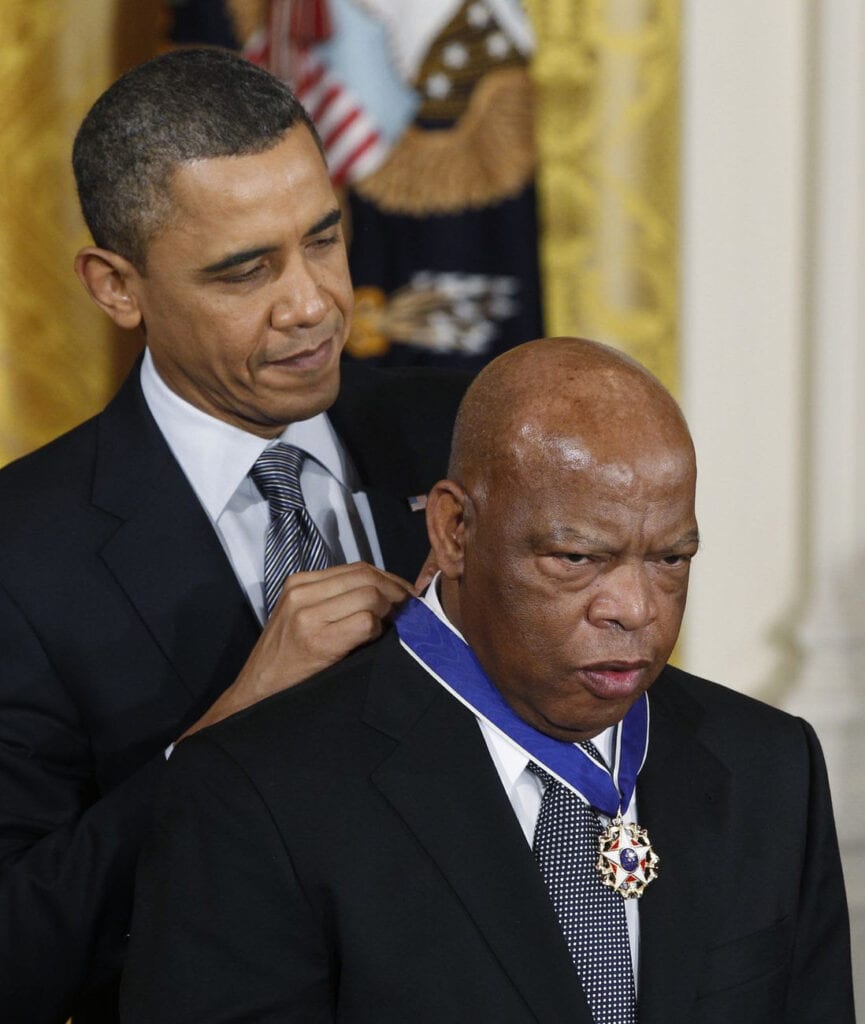
President Barack Obama honors Congressman John Lewis with the Medal of Freedom in 2010: White House
Birmingham Civil Rights Institute
It would be an exaggeration to call John Lewis my friend, but I did have a few occasions to get to know him in person, and I was blown away by the man’s powerful presence and genuine humility. We first met on the day of the grand opening of the Civil Rights Institute in my home town of Birmingham in November 1992.
I had just moved back to Birmingham from Gulf Shores, Alabama, and was living temporarily with photographer Spider Martin on Southside. While getting together my application for grad school at the University of Alabama in Tuscaloosa, I signed a contract to work as Spider’s agent to help him organize and begin to try to sell his collection of iconic civil rights photographs and negatives. They included some of the best news pictures from Bloody Sunday, including the one of Lewis with a billy club blurring as it comes down on his head, with a cloud of tear gas and melee in the background.
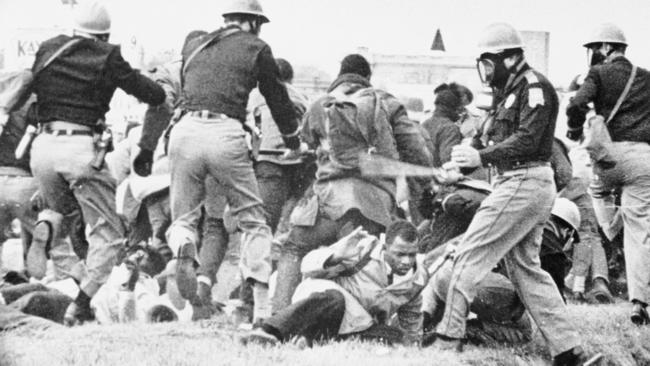
An Alabama state trooper swings his club at future U.S. Rep. John Lewis, pictured on the ground, during “Bloody Sunday” in Selma, Ala., in 1965: Photo by my good friend James “Spider” Martin
In the week before the institute was supposed to open, the place was not ready for the crowds expected to come. Most of the rooms were empty and without exhibits. Spider and I met with Odessa Woolfolk, the first director, and came to an agreement that Spider would do an exhibit on opening day that would remain up for a month. As we came in to setup, we discovered there was no way to hang photographs on the walls. The place was not yet setup as a museum.
So we scrambled to find a way. I had the idea of using tripod stands like those florists use to display flowers at funerals to display the framed prints, so we took Spider’s Ford Econoline van and drove all over town borrowing stands from flower shops.
The exhibit was a major hit, and people thought the stands were a planned part of the display. We didn’t tell them we did it because the museum was not ready with mounts embedded in the walls.
John Lewis Meets With Spider Martin
When John Lewis himself came through, he commented on the stands. He said it was a “powerful” display, and I shook his hand that day and sat in on a meeting between Lewis and Spider about setting up a showing in the U.S. Capitol Building in Washington, D.C. That later came about, and I was there when Spider made the print in his darkroom of the iconic image he presented to Lewis as a gift to hang in his office in D.C.
When Spider died in the spring of 2003, I talked to Lewis on the phone and at the funeral, where I was a pallbearer, and he agreed to write an introduction for a planned book on Spider’s life. The book never came about, because there was no funding and there were problems dealing with Spider’s family. But Spider documented a quote from Dr. King about the role of the press in the movement that is now a firm part of the history of the time.
“Spider, we could have marched, we could have protested forever, but if it weren’t for guys like you, it would have been for nothing,” Dr. King said. “The whole world saw your pictures. That’s why the Voting Rights Act passed.”
Many times, Lewis told people similar things about the role of the press. For example, in an interview with Rolling Stone magazine, when asked: “How important was the press to the civil-rights movement?”
“If it hadn’t been for the press,” Lewis said, “the civil-rights movement, the whole struggle would have been like a bird without wings. I believe that. For the press, it was very dangerous, especially in the American South, to be a reporter, to be there with a pen and a pad, with a camera. I saw members of the Klan and racists turning on the media, beating people, leaving them bloody, and then turning on us.”
David Halberstam, then a reporter for The Nashville Tennessean, later described the scene: “The protests had been conducted with exceptional dignity, and gradually one image had come to prevail — that of elegant, courteous young Black people, holding to their Gandhian principles, seeking the most elemental of rights, while being assaulted by young white hoodlums who beat them up and on occasion extinguished cigarettes on their bodies.”
A schism in the movement had opened up between those who wanted to express their rage and fight back and those who believed in pressing on with nonviolence, a lesson that should not be lost on the Black Lives Matter movement today. Mr. Lewis chose nonviolence, but he did not shy away from trouble.
“Do not get lost in a sea of despair,” Lewis recently said on Twitter in one of his last posts. “Be hopeful, be optimistic. Our struggle is not the struggle of a day, a week, a month, or a year, it is the struggle of a lifetime. Never, ever be afraid to make some noise and get in good trouble, necessary trouble.”
Spider also defied the establishment editors at the Birmingham News back in those days and got into a bit of trouble for daring to cover civil rights protests.
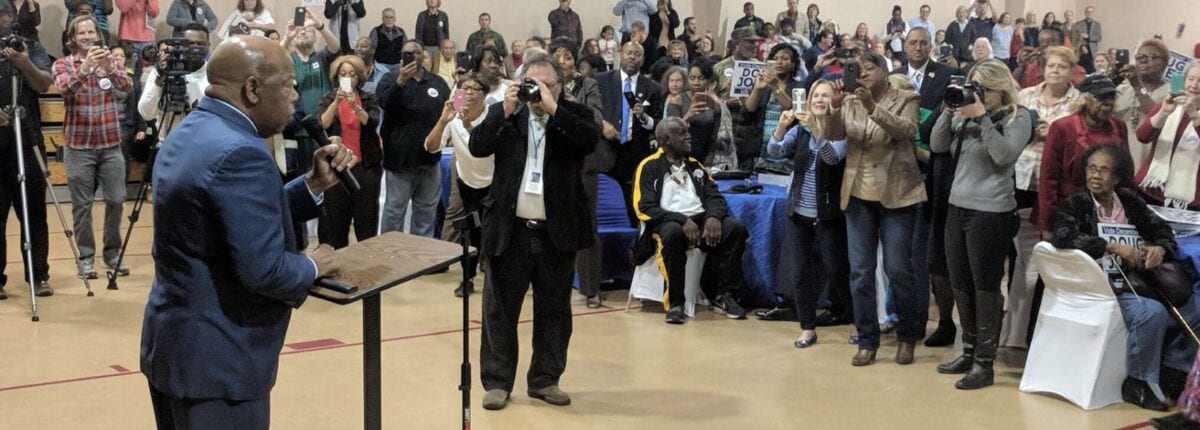
That’s me in black taking pictures and shooting video: Doug Jones
I was also there when John Lewis came to Mobile County in 2017 to campaign for Doug Jones. I shot this video, which went viral on Twitter and Facebook then. People should make it go viral again. It is just as relevant today.
“Vote like you’ve never voted before,” Lewis admonished.
We better do that in November.
Read the full feature obituary in the New York Times here: John Lewis, Towering Figure of Civil Rights Era, Dies at 80
Also this editorial from the New York Times editorial board: John Lewis Risked His Life for Justice
The essence of the nonviolent life, Lewis believed and wrote, involved the capacity to forgive and to understand that your attacker is as much a victim as you are: “Even as a person is cursing you to your face, even as he is spitting on you, or pushing a lit cigarette into your neck…”
His philosophy, as difficult to adopt and live by as the teachings of Jesus themselves, rested upon the belief that people of good will — “the Beloved Community,” as Mr. Lewis called them — would rouse themselves to combat evil and injustice.
The Ku Klux Klan did its best to secure such a sacrificial outcome. It firebombed a bus at Anniston, Ala., and tried unsuccessfully to burn the Freedom Riders alive by holding the exit doors shut.
In his memoir Walking With the Wind published in 2015, Lewis describes the especially harrowing episode that unfolded on the Freedom Ride bus on which he arrived in Montgomery.
The terminal seemed nearly deserted, he writes, but “then, out of nowhere, from every direction, came people. White people. Men, women and children. Dozens of them. Hundreds of them. Out of alleys, out of side streets, around the corners of office buildings, they emerged from everywhere, from all directions, all at once, as if they’d been let out of a gate . … They carried every makeshift weapon imaginable. Baseball bats, wooden boards, bricks, chains, tire irons, pipes, even garden tools — hoes and rakes. One group had women in front, their faces twisted in anger, screaming, ‘Git them niggers, GIT them niggers!’ … And now they turned to us, this sea of people, more than three hundred of them, shouting and screaming, men swinging fists and weapons, women swinging heavy purses, little children clawing with their fingernails at the faces of anyone they could reach.”
Lewis may have clashed with the elder statesmen of the movement about some things, but not about non-violent confrontation. Dr. King and others prevailed on him to tone down a speech he was about to give at the March on Washington in 1963. He complied and deleted the harshest criticisms of the John F. Kennedy administration’s civil rights bill as well as a fiery passage threatening that the movement would “march through the South, through the heart of Dixie, the way Sherman did. We shall pursue our own scorched earth policy and burn Jim Crow to the ground — nonviolently.”
To the dismay of many, the 23-year-old Mr. Lewis described the movement as “a revolution,” appealing to all who listened “to get into this great revolution that is sweeping this nation. Get in and stay in the streets of every city, every village and hamlet of this nation until true freedom comes, until a revolution is complete. We must get in this revolution and complete the revolution.”
But in fact it was a revolution, and history has proven Lewis right about that.
“The passing of John Lewis deprives the United States of its foremost warrior in a battle for racial justice that stretches back into the 19th century and the passage of the 14th and 15th Amendments. Americans — and particularly his colleagues in Congress — can best honor his memory by picking up where he left off,” writes the New York Times.
Yes, and the revolution continues, as Lewis told CBS News: “It was very moving, very moving to see hundreds of thousands of people from all over America and around the world take to the streets — to speak up, to speak out, to get into what I call ‘good trouble’.”
“This feels and looks so different,” he said of the Black Lives Matter movement, which drove the anti-racism demonstrations. “It is so much more massive and all inclusive.” He added, “There will be no turning back.”
No Turning Back
Even as Donald Trump presses to deny funding for more testing to try to save his reelection campaign from the depths of defeat as the coronavirus continues to grow and spread, in large measure due to his administration’s anti-science and alt-reality response, data shows that at least college educated Republicans are just not going to take this anymore. They are leaving the Republican Party in droves.
Gallup Polls Show Trump’s Damage to Republican Party: Elections 2020 Are Democrats to Lose
While John Lewis is being elevated to historic hero’s status on this Sunday in the fifth month of the year of the novel coronavirus, that emerged from nature to attack humanity maybe for its sins, Trump seems more destined than ever for the scrap heap of history, along with his followers who still want to fly some version of the Confederate flag alongside the American stars and bars.
Not Since Nixon Has a President Been So Isolated and Hated: Trump Has to Go
John Lewis knew we can’t have it both ways. We can’t fly both flags and survive as a democratic republic. So let’s honor him by burning the Confederate flag for the final time, and put his name prominently on that bridge in Selma named after an officer in the Confederate Army and a leader in the Ku Klux Klan of the time.
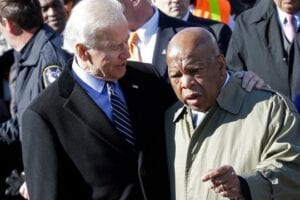
Joe Biden with John Lewis in Selma: Google
I understand there are those who think there should be a local debate in Selma about whose name should appear on that bridge. They can debate it all they want, but the bridge crosses the Alabama River on U.S. Route 80, a federal highway, which is also a state highway, 209. It is not a decision for the Selma city council to make.
It should be renamed as soon as possible, in my view, by an act of Congress if necessary, as the John Lewis Memorial Bridge. Do it after his funeral and right before Joe Biden is elected president of the United States in November.
John Lewis is the one who made that bridge famous. He used it to great success more than any other. It is his bridge. Put his name on it.
___
If you support truth in reporting with no paywall, and fearless writing with no popup ads or sponsored content, consider making a contribution today with GoFundMe or Patreon or PayPal.














Your passion shines through on this one. Thank you, Glynn!
John Lewis would give this article a “two thumbs up,” Glynn. Well-done!
Outstanding. Sadly, the good folks we know are here but for a while but will always have a home in our hearts while the saber rattling and venom spewing of others become a distant memory as a bad dream.